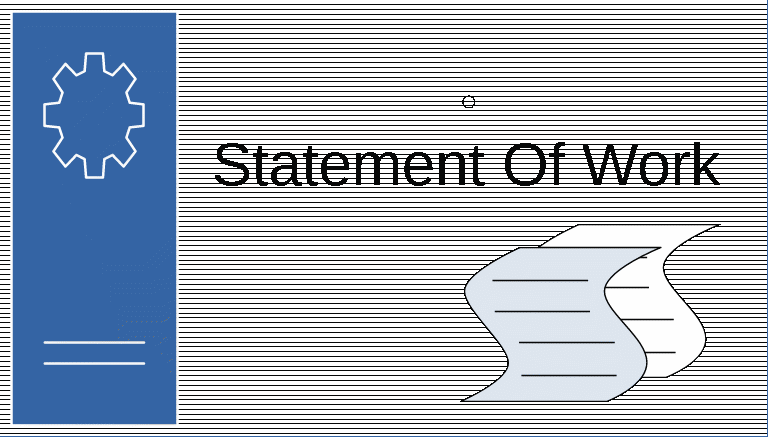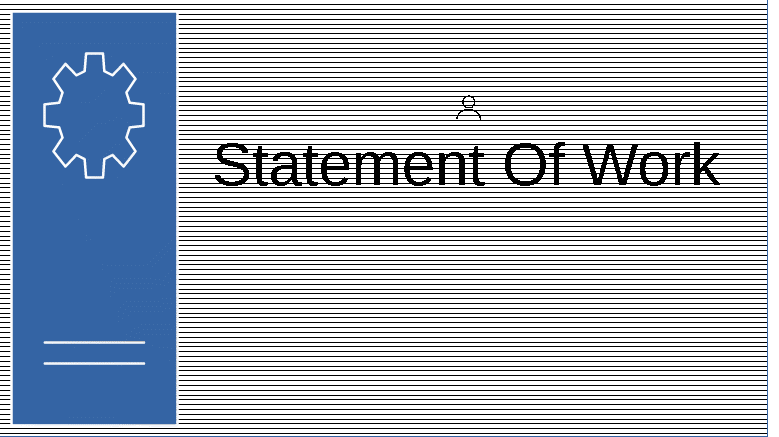In software project management, the Statement of Work (SOW) is a formal document that plays a crucial role in outlining the specifics of a project. It serves as a reference and agreement between the client or project sponsor and the project team or vendor, establishing a clear understanding of the project’s objectives, deliverables, scope, timeline, and other relevant details.
The SOW begins with a comprehensive project overview, providing a high-level description of the project’s purpose and expected outcomes. It then proceeds to articulate the specific objectives, setting clear and precise statements about what the project aims to achieve.
One of the most critical sections of the SOW is the scope of work, which delves into the granular details of the tasks, activities, and deliverables encompassed by the project. By defining the project’s boundaries, this section helps establish what is within the project’s scope and what lies outside it.
The SOW also incorporates a timeline, outlining the major milestones, deadlines, and dependencies that need to be met throughout the project. This schedule ensures proper project planning and enables effective tracking of progress.
Furthermore, the SOW identifies the necessary resources required for the project’s successful execution. This includes personnel, equipment, software, or any other essential assets that are vital to achieving the project’s goals.
To manage expectations and address potential challenges, the SOW incorporates a section for assumptions and constraints. This helps both the client and the project team understand any underlying assumptions or limitations that may impact the project’s execution or outcomes.
The SOW also includes acceptance criteria, which specify the standards that the project deliverables need to meet in order to be considered acceptable and approved by the client.
Finally, the SOW addresses the financial aspects of the project, including the estimated cost, payment schedule, and any specific terms related to billing or invoicing.
Overall, the SOW serves as a crucial document for software project management, establishing a common understanding between the client and the project team. It provides a comprehensive overview of the project’s goals, deliverables, and expectations, serving as a baseline for effective project management, control, and successful project completion.
The SOW serves as a reference and agreement between the client or project sponsor and the project team or vendor.
The SOW typically includes the following components:
Project Overview: A high-level description of the project, its purpose, and the expected outcomes.
Objectives: Clear and specific statements of what the project aims to achieve.
Scope of Work: A detailed description of the tasks, activities, and deliverables that are included in the project. This section helps define the boundaries of the project and what is considered in-scope and out-of-scope.

Timeline: A schedule or timeline that outlines the major milestones, deadlines, and dependencies of the project.
How to come up with timeline?
Creating a timeline for a Statement of Work (SOW) requires careful planning and consideration of various factors. Here are some steps to help you come up with a realistic and effective timeline for your SOW:
- Define project tasks and activities: Start by identifying all the tasks and activities required to complete the project. Break down the project into smaller, manageable components, and list them in a logical sequence. This could include activities such as requirements gathering, design, development, testing, implementation, and training.
- Estimate task durations: Estimate the time required to complete each task or activity. Consider the complexity, resources needed, dependencies, and any potential risks or challenges associated with each task. Consult with subject matter experts, team members, or previous project data to gather insights and make accurate estimations.
- Identify task dependencies: Determine the dependencies between tasks. Some tasks may need to be completed before others can begin. Identify any sequential or overlapping relationships among the tasks and account for them in your timeline. This helps ensure that tasks are scheduled in a logical and efficient manner.
- Allocate resources: Consider the availability and allocation of resources such as team members, equipment, and software. Factor in any potential resource constraints or limitations that may impact the timeline. Ensure that the necessary resources are available when needed to avoid delays or bottlenecks.
- Consider risk management: Assess potential risks and uncertainties that may affect the timeline. Account for contingencies and buffer time to accommodate unexpected events, such as scope changes, resource unavailability, or technical challenges. This helps mitigate the impact of risks on the project schedule.
- Determine milestones: Identify key milestones or checkpoints throughout the project. These milestones serve as important markers to track progress and ensure that the project is on track. Milestones can be associated with the completion of major deliverables or the achievement of specific project objectives.
- Validate the timeline: Review and validate the timeline with relevant stakeholders, including the project team, clients, and any other key individuals involved. Consider their feedback and make necessary adjustments to the timeline based on their input. Aim for a realistic and achievable schedule that aligns with everyone’s expectations.

- Communicate and document: Document the timeline clearly within the SOW. Include start dates, end dates, task durations, milestones, and any critical dependencies. Ensure that the timeline is communicated effectively to all stakeholders, providing a shared understanding of the project’s schedule.
Creating an accurate timeline requires experience, domain knowledge, and collaboration with the project team. Regularly monitor and update the timeline throughout the project to track progress and make necessary adjustments as the project evolves.
Resources: Identification of the resources required for the project, such as personnel, equipment, software, or any other necessary assets.
Resource identification is a crucial aspect of the Statement of Work (SOW) in software project management. This section of the SOW explicitly identifies and allocates the resources necessary for the successful execution of the project. It encompasses personnel, equipment, software, and any other assets required to achieve the project’s objectives. In the SOW, the resource identification section outlines the roles and responsibilities of individuals or teams involved, specifying the skills and qualifications needed. It also addresses the hardware, software, and infrastructure needed to support the project, including servers, computers, development and testing tools. Additionally, it may highlight any external vendors or contractors, along with their responsibilities and deliverables. Facilities, physical resources, and training requirements, including materials and trainers, are also included. By documenting resource requirements in the SOW, both the client and project team can align expectations and ensure the availability of necessary resources throughout the project, thereby enhancing its overall success.
Assumptions and Constraints: Any assumptions or limitations that may impact the project’s execution or outcomes.
The assumptions and constraints section within the Statement of Work (SOW) in software project management is crucial for setting expectations and addressing potential challenges. It helps both the client and the project team understand any underlying assumptions or limitations that may impact the project’s execution or outcomes.
In this section, the SOW explicitly states the assumptions made during the project’s planning and scoping. These assumptions may include factors such as the availability of certain resources, the stability of underlying systems or platforms, the accuracy of provided data, or any other factors that are considered as prerequisites for the project’s success. By outlining these assumptions, the SOW ensures that all parties have a shared understanding of the project’s dependencies and potential risks.
Similarly, the constraints section of the SOW specifies any limitations or restrictions that may impact the project’s execution. These constraints may be related to budgetary limitations, time constraints, regulatory requirements, technological limitations, or any other factors that may restrict the project’s scope or affect its progress. By acknowledging these constraints upfront, the SOW helps manage expectations and enables the project team to plan and execute accordingly.
For instance, a common assumption in software development projects could be that the client will provide accurate and complete requirements at the beginning of the project. This assumption implies that any changes or additions to the requirements later in the project may impact the timeline or cost. Additionally, a constraint may be imposed by a fixed budget, which limits the project team’s ability to invest in certain resources or technologies.
The assumptions and constraints section plays a crucial role in aligning the client’s expectations with the project team’s capabilities. By explicitly stating these assumptions and constraints in the SOW, all stakeholders can understand the potential risks and limitations associated with the project, allowing for more effective planning, risk management, and decision-making throughout the project’s lifecycle.
Acceptance Criteria: The criteria that need to be met for the project deliverables to be considered acceptable and approved by the client.
Cost and Payment Terms: The financial aspects of the project, including the estimated cost, payment schedule, and any specific terms related to billing or invoicing.
The SOW is a critical document as it provides a common understanding between the client and the project team about the project’s goals, deliverables, and expectations. It helps ensure that both parties are aligned and provides a baseline for managing and controlling the project throughout its lifecycle.
Identifying deliverables in SOW
Identifying deliverables is an essential part of the Statement of Work (SOW) in software project management. The deliverables section specifies the tangible outcomes or results that will be produced and provided to the client or project stakeholders upon project completion. Here’s how deliverables are typically addressed in the SOW:

The deliverables section of the SOW provides a comprehensive list of the specific items, documents, or software components that will be delivered at different stages of the project. These deliverables can include software modules, reports, design documents, user manuals, test plans, training materials, or any other artifacts that are expected to be produced during the project.
Each deliverable should be described in sufficient detail to ensure clarity and understanding. This includes specifying the format, level of detail, and any specific requirements or standards that need to be followed. The SOW should also outline the acceptance criteria for each deliverable, clarifying the conditions that must be met for the client to consider the deliverable as satisfactory.
Additionally, the SOW should establish the timeline for each deliverable. This includes defining the milestones or checkpoints when specific deliverables are expected to be completed or submitted. By providing a clear timeline, the SOW helps both the client and the project team track progress and ensure that deliverables are delivered in a timely manner.
Furthermore, the SOW may address dependencies among deliverables, highlighting any sequential or interdependent relationships. This ensures that the project progresses smoothly and that subsequent deliverables can be developed based on the completion of preceding ones.
It is also important to note any limitations or exclusions in the deliverables section. This helps manage expectations by specifying what is not included as part of the deliverables, thus avoiding misunderstandings or scope creep.
The deliverables section of the SOW serves as a reference and agreement between the client and the project team, ensuring that both parties have a clear understanding of the tangible outcomes that will be produced throughout the project. It facilitates effective project management, enables progress tracking, and helps measure the success of the project against the defined deliverables.
Understanding the important cost and payment terms in SOW
The cost and payment terms in a Statement of Work (SOW) are derived through a collaborative process involving the client and the project team. Here are the key steps involved in determining the cost and payment terms for a SOW:
1. Scope and Requirements Analysis: Thoroughly analyze the project’s scope and requirements. Understand the client’s needs, objectives, and desired outcomes. This analysis helps in determining the effort, resources, and costs associated with fulfilling the project requirements.
2. Cost Estimation: Break down the project into individual tasks and activities. Estimate the effort, time, and resources required to complete each task. Consider factors such as the complexity of the work, skill levels needed, and any specialized tools or technologies required. Consult with subject matter experts and project team members to gather accurate estimates.
3. Resource Allocation: Identify the resources needed for the project, including personnel, equipment, software licenses, and other necessary assets. Determine the cost associated with acquiring or utilizing these resources. Consider factors such as labor rates, procurement costs, and any recurring expenses.
4. Cost Calculation: Calculate the total cost for the project by aggregating the estimated costs for each task and resource. Take into account any contingency or buffer amounts to cover unforeseen expenses or risks.
5. Pricing Strategy: Determine the pricing strategy based on various factors, such as market conditions, competition, value delivered, and client expectations. Consider whether the pricing will be based on a fixed price, time and materials, or any other mutually agreed-upon pricing model.
6. Payment Terms: Define the payment terms in the SOW. Specify the payment schedule, including the amount, timing, and method of payment. Common payment terms include milestone-based payments, phased payments, or a percentage-based payment structure. It’s important to align the payment terms with the project’s timeline and milestones.
7. Negotiation and Agreement: Engage in negotiations with the client to finalize the cost and payment terms. Consider any client-specific requirements or constraints that may impact the pricing or payment structure. Seek a mutually beneficial agreement that meets the client’s budget and the project team’s financial needs.
8. Documentation: Document the cost and payment terms clearly within the SOW. Provide a breakdown of the estimated costs, payment schedule, and any specific conditions or terms related to billing or invoicing.
Throughout the process, open communication and collaboration between the client and the project team are crucial. It’s important to ensure that both parties have a shared understanding of the cost implications and payment terms, and that they align with the overall project goals and objectives.




